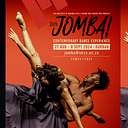CHALLENGING ATTITUDES AROUND DISABILITY WITH JOSEPH TEBANDEKE AND UNMUTE DANCE THEATRE
By Samkelisiwe Nxumalo
What an ineffable performance I have just watched! On 31 August at UKZN’s Elizabeth Sneddon Theatre we experienced a performance by Joseph Tebandeke in “Time Machine: Unveiling the Inner Strength” and Unmute Dance Theatre in “TIMELAPSE” by Andile Vellem, Nadine Mckenzie and Yaseen Manuel. JOMBA! 2023 continues its support by offering dance work that makes visible that which has been rendered invisible through intersections around dance and disability by focusing on deconstructing ideas of who can dance and who has the right to be on stage.
The opening performance by Joseph Tebandeke from Uganda challenges the audience to reconstruct their thoughts around crutches generally; a person who uses crutches is viewed as someone who is fragile and cannot dance, but he provokes audiences to see crutches as an important part of his life that allow him to do things that seem to be impossible like contemporary dance. In his performance, he shows the struggle of living without crutches by the way he moves — it’s like he is feeling pain in his body, and also when he is down on the floor he uses his crutches to stand. The crutches are an important addition to his body which brings hope when he is hopeless and encourages him to continue standing even when he feels sad. What stood out for me was the moment when he was collecting broken pieces of crutches that he had smashed broken on the stage, and trying to mend them; it seems he was constructing his ideas that walking with crutches does not mean you are incapable of dancing and also symbolising his life in Uganda. During his on-stage interview after the performance, he revealed that when you lose crutches, you are given any crutches that are available at that time, some of which might be broken so the important part is understanding your body so that you can adapt to its needs. He also invites the audience to really see the crutches by showing them directly to us and sharing the idea that using crutches or being disabled is not contagious.
Unmute Dance Theatre presents mixed abilities/disabilities that use physical theatre and dance to advocate for accessibility and inclusion of people with disabilities; there are able/disabled dancers dancing as equals. It begins with a triangle which for me symbolises the unity, power and trust they have for each other as a group. As they move within one circle at the beginning it looked as if they were one and equal regardless of the differences they have (Mckenzie is in a wheelchair and Vellem is deaf).They give voice to the ones who cannot speak vocally but use their bodies to speak for themselves. The dancers use the wheelchair as a body and not a prop because walking with a chair is part of a person. They spin it, move it around, carry it, dance on it; it is an integral part of the performance.
The two performances connect as they both show the audience the capabilities of the body labelled as “disabled” and that there is no need to feel sorry for them; they are also capable of doing things like everyone else, we just need to accept difference and stop comparing.
